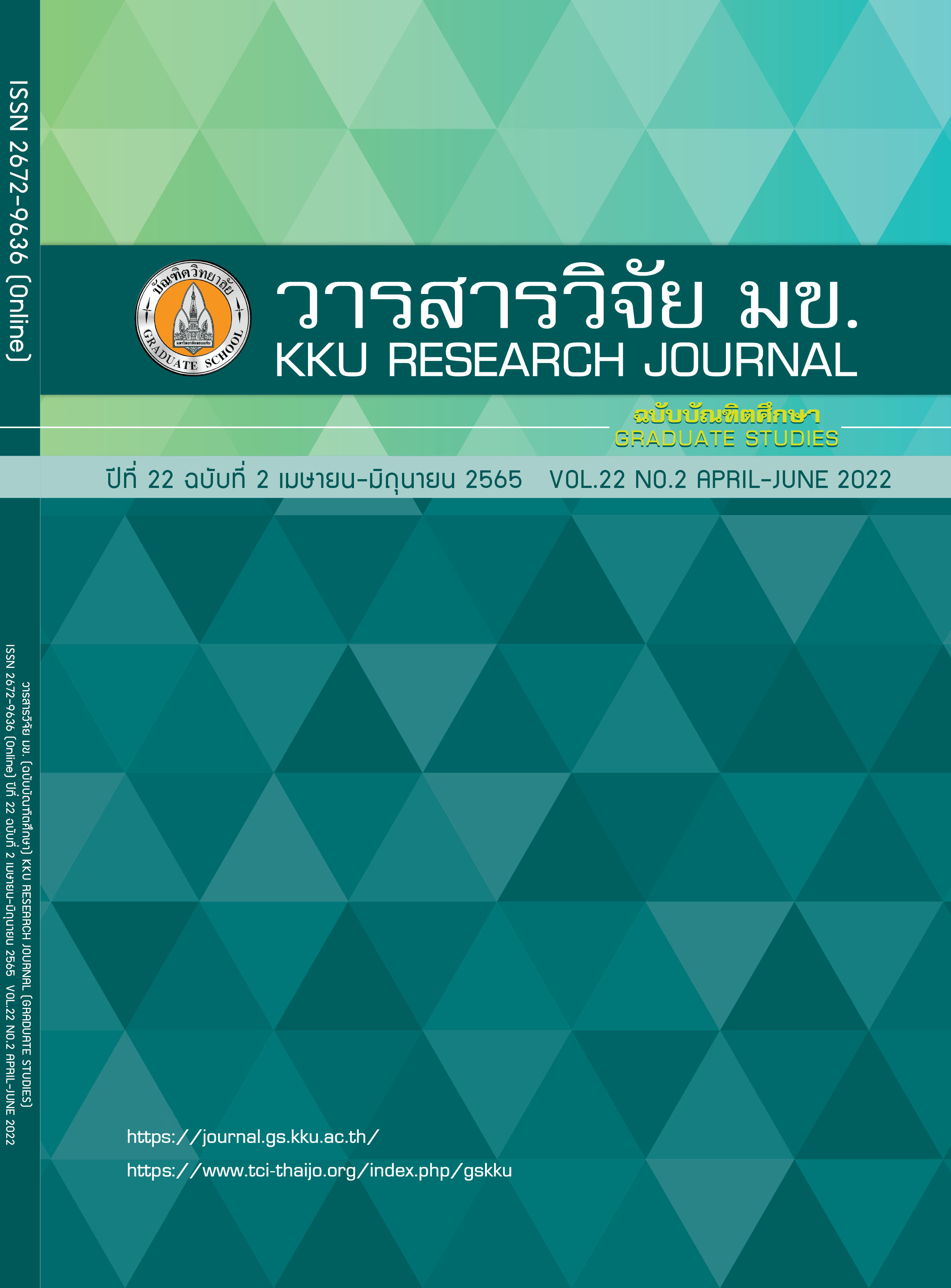การวิเคราะห์ปริมาณเบอจีนินในสารสกัดแคลลัส กิ่ง และรากของมะเดื่อชุมพร (Ficus racemosa) โดยวิธี โครมาโทกราฟีของเหลวสมรรถนะสูง
คำสำคัญ:
เบอจีนิน, มะเดื่อชุมพร, โครมาโตกราฟีของเหลวสมรรถนะสูงวัฏภาคย้อนกลับบทคัดย่อ
รากมะเดื่อชุมพร เป็นตัวยาหนึ่งของตำรับยาห้าราก หรือตำรับเบญจโลกวิเชียร มีฤทธิ์แก้ไข้ จากการศึกษาที่ผ่านมาพบว่าในเปลือกรากมะเดื่อชุมพรมีการพบสารเบอจีนิน มีฤทธิ์ ต้านอักเสบ ต้านเชื้อจุลชีพ และมีฤทธิ์ลดไข้ แต่ไม่พบการรายงานปริมาณสารสำคัญที่พบในรากมะเดื่อชุมพรและส่วนอื่นๆเช่น กิ่งก้าน และแคลลัสจากการเพาะเลี้ยงเนื้อเยื่อพืช ในการวิจัยครั้งนี้จึงมีวัตถุประสงค์เพื่อศึกษาปริมาณเบอจีนินในรากมะดื่อชุมพร รวมทั้ง แคลลัส และกิ่งก้าน ด้วยวิธี โครมาโทกราฟีของเหลวสมรรถนะสูงวัฏภาคย้อนกลับ (RP-HPLC) วัฏภาคเคลื่อนที่ประกอบด้วย อะซิโตไนไตรล์และน้ำ (10:90 โดยปริมาตร) ที่อัตราการไหล 0.8 มิลลิลิตรต่อนาที ตรวจวัดเบอจีนินที่ความยาวคลื่น 272 นาโนเมตร ผลการศึกษาพบว่า เวลารีเทนชั่นที่แสดงพีคของเบอจีนินคือ 10.237 นาที วิเคราะห์ปริมาณเบอจีนินในช่วง 10-320 ไมโครกรัมต่อมิลลิตร พบความสัมพันธ์เชิงเส้นตรงที่ R2= 0.9999 ความถูกต้องของวิธีทดสอบ รายงานด้วยค่าร้อยละการคืนกลับ ความเข้มข้นที่ 30, 60, และ 120 ไมโครกรัมต่อมิลลิลิตร มีค่า เท่ากับ 98.009 ± 0.168, 102 ± 0.621 และ 98.807 ± 0.188 ตามลำดับ ความแม่นยำภายในวันเดียวกัน(intraday) พบว่าค่า %RSD เท่ากับ 0.703-1.822 % และ ระหว่างวัน (interday) ค่า %RSD เท่ากับ 0.251-1.982 ปริมาณความเข้มข้นต่ำสุดที่สามารถตรวจวัดได้ และปริมาณความเข้มข้นต่ำสุดของสารซึ่งเป็นที่ยอมรับได้เท่ากับ 5.23 และ 15.84 ไมโครกรัมต่อมิลลิลิตร ตามลำดับ สำหรับสารสกัดของแคลลัส กิ่งและ ราก พบว่า ในสารสกัดส่วนน้ำของกิ่งพบปริมาณเบอจีนินสูงที่สุดคือ 2.06±0.00% ของน้ำหนักแห้ง รากพบปริมาณเบอจีนิน 0.646±0.00% ของน้ำหนักแห้ง และในแคลลัสพบปริมาณเบอจีนินน้อยที่สุดที่ 0.018±0.00% ของน้ำหนักแห้ง การวิเคราะห์ปริมาณเบอจีนินด้วยสภาวะเครื่อง HPLC ที่กำหนด ผ่านเกณฑ์ที่ยอมรับได้ตามหลัก AOAC Guidelines for Single Laboratory Validation of Chemical Methods for Dietary Supplements and Botanicals (2002) และยังสามารถใช้วิเคราะห์ปริมาณเบอจีนินใน แคลลัส กิ่งและราก ของมะเดื่อชุมพรได้
เอกสารอ้างอิง
Bhalerao SA, Verma DR, Teli NC, Didwana VS, Thakur SS. Ficus racemosa Linn.: a comprehensive review. Journal of Applicable Chemistry. 2014;3(4):1423-1431.
Rachan Phuma, Samran Soodee, Editor. Name of species of plants of Thailand, Tem Samitinan, revised version 2014. Bangkok: Hospice Office. Office of Forest and Plant Conservation Research Department of National Parks, Wildlife and Plant Conservation. 2014.Thai.
Division Arts of Healing. General textbooks of traditional Thai traditional medicine. Pharmaceutical field. Nonthaburi: Office of the Permanent Secretary, Ministry of Public Health. 1999. Thai.
Paarakh PM. Ficus racemosa Linn. –an overview. Natural product Radiance. 2009;8(1): 84-90.
Jain R, Rawat S, Jain SC. Phytochemicals and antioxidant evaluation of Ficus racemosa root bark. Journal of Pharmacy Research. 2013; 6(6):615-619.
Singh DP, Srivastava SK, Govindarajan R, Rawat AK. High-performance liquid chromatographic determination of bergenin in different Bergenia species. Acta Chromatographica. 2007; 19:246.
Pushpalatha HB, Pramod K, Devanathan R, Sundaram R. Use of bergenin as an analytical marker for standardization of the polyherbal formulation containing Saxifraga ligulata. Pharmacognosy magazine. 2015 May;11(Suppl 1): S60.
Khan MS, Khan W, Ahmad W, Singh M, Ahmad S. Bergenin determination in different extracts by high-performance thin-layer chromatographic densitometry. Journal of pharmacy & bioallied sciences. 2015 Oct;7(4):272.
Boros B, Jakabová S, Madarász T, Molnár R, Galambosi B, Kilár F, Felinger A, Farkas Á. Validated HPLC method for simultaneous quantitation of bergenin, arbutin, and gallic acid in leaves of different Bergenia species. Chromatographia. 2014 Sep 1;77(17-18):1129-1135.
Hussain A, Alam P, Siddiqui NA, Alajmi MF, Rehman MT, Kalam MA, Al-Rehaily AJ. Development and validation of UPLC-PDA method for concurrent analysis of bergenin and menisdaurin in aerial parts of Flueggea virosa (Roxb. ex Willd.). Saudi Pharmaceutical Journal. 2018 Nov 1;26(7):970-976.
Subramanian R, Subbramaniyan P, Raj V. Isolation of bergenin from Peltophorum pterocarpum flowers and its bioactivity. Beni-Suef University Journal of Basic and Applied Sciences. 2015 Sep 1;4(3):256-261.
Sriset Y, Chatuphonprasert W, Jarukamjorn K. Quantitative determination of bergenin in Mallotus repandus (Willd.) Muell. Arg. Stem Extract by Reverse Phase-High Performance Liquid Chromatography. Isan Journal of Pharmaceutical Sciences. 2018 Apr 21;14(1):67-74.
Muniz MP, Nunomura SM, Lima ES, Lima AS, Almeida P, Nunomura R. Quantification of bergenin, antioxidant activity and nitric oxide inhibition from bark, leaf and twig of Endopleura uchi. Química Nova. 2020 Apr;43(4):413-418.
Bajracharya GB. Diversity, pharmacology and synthesis of bergenin and its derivatives: potential materials for therapeutic usages. Fitoterapia. 2015 Mar 1; 101:133-152.
Patel DK, Patel K, Kumar R, Gadewar M, Tahilyani V. Pharmacological and analytical aspects of bergenin: a concise report. Asian Pacific Journal of Tropical Disease. 2012 Apr 1;2(2):163-167.
Jain R, Rawat S, Jain SC. Phytochemicals and antioxidant evaluation of Ficus racemosa root bark. Journal of Pharmacy Research. 2013 Jun 1;6(6):615-619.
Veerapur VP, Prabhakar KR, Thippeswamy BS, Bansal P, Srinivasan KK, Unnikrishnan MK. Antidiabetic effect of Ficus racemosa Linn. stem bark in high-fat diet and low-dose streptozotocin-induced type 2 diabetic rats: a mechanistic study. Food Chemistry. 2012 May 1;132(1):186-193.
Phutalun W. Cultivation of herbal tissue culture Educational guidelines to produce secondary substances with pharmacological effects. Khon Kaen: Khon Kaen Print Pattana. Thai.
Prommakool A, Vongchaisitti W, Uksan Irada, Phattayakorn K. Ultrasonic- assisted extraction of anthocyanins from Mao marcs. Khon kaen agriculture Journal. 2015; 43(1):882-835. Thai.
AOAC Guidelines for Single Laboratory Validation of Chemical Methods for Dietary Supplements and Botanicals; 2002.
ดาวน์โหลด
เผยแพร่แล้ว
ฉบับ
ประเภทบทความ
สัญญาอนุญาต
ลิขสิทธิ์ (c) 2022 วารสารวิจัย มข. (ฉบับบัณฑิตศึกษา)

อนุญาตภายใต้เงื่อนไข Creative Commons Attribution-NonCommercial-NoDerivatives 4.0 International License.



